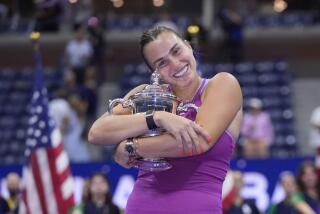She Went to Wall, and Turned Into Major Tennis Star
- Share via
The first look you get at Gabriela Sabatini, you wonder who the criminal was who put a tennis racket in her hands. It’s like outfitting Sharon Stone with a javelin. Or a discus.
This is one of the great beauties of our time. Forget Hollywood. You imagine Helen of Troy looked like this. Bathsheba. Eleonora Duse.
Da Vinci would want to paint her. She would hang in the Louvre if she had come along in his lifetime.
First of all, there are these large luminous dark eyes, as black as midnight, with a hint of sadness in them, lashes a movie queen would envy, only they are hers, not Westmore’s. She has the kind of coloring people lie in the sun in Martinique all winter to get--dark olive, as smooth as a rose petal.
She doesn’t need tennis. She should be an opera star. She has this air of sad mystery about her that kings leave thrones for. What she is doing in an activity where love is a shutout is something for someone else to answer for. She should be driving men mad in remakes of “Camille” or on Broadway playing O’Neill’s most tragic heroines.
Of course, without tennis, nobody might have known this except for a few bouquet-carrying caballeros from Buenos Aires. It’s really the fault of her brother, Osvaldo Jr. She used to follow him everywhere when they were growing up in Argentina. One of the places he went was to the tennis court. Little sister tagged along, but he wouldn’t let her play--so she spent her time hitting a ball off a grandstand wall. A coach came along and marveled at her natural ability. “I was hitting some very good shots,” she recalls. The wall never won a point.
“He asked me if I wanted to work on my backhand,” Sabatini says. It was a fateful question. Pretty soon, the 8-year-old Gabriela was defeating 12-year-olds and some of the greatest young players in Argentina. She caught the eye of a Chilean expert, Patricio Apey.
When she could have been playing with dolls in her bedroom, she was playing tennis all over the world against players four to six years older than her--and beating them.
Apey took her to Florida to test her game against the best youngsters there. When they couldn’t get the ball by her, he knew he had another Maria Bueno. Or Chrissie Evert.
Painfully shy, adrift in a bewildering world where people talked fast and funny, the budding young beauty had nothing but tennis to cling to. She spent her days playing tennis and her nights crying. She recalls: “I was crying all the time. I was alone, I was far from home. My parents came to stay with me sometimes, but when they went home, I would fall apart.”
Sabatini was not one of those prodigies pushed into games by doting or manipulative mothers or fathers. Her parents made it clear they would welcome her going back to school if her career were to stop. Tennis was not their priority, it was hers.
“My career didn’t stop,” she says. “I loved the game, if not the rest of it.” She was precocious. She played in the U.S. Open at 14 and got to the third round before being eliminated by Helena Sukova.
She turned pro at 15. She progressed steadily. It was nothing you could put your finger--or your racket--on. “She just keeps backing you up,” is the way her coach, former U.S. Davis Cupper Dennis Ralston, puts it. If she had a weakness, it was that her serve was somewhat less than intimidating. But her ground strokes were “heavy,” hard to get a racket around or through. “She hits as hard as some of the guys,” Ralston says.
When she made the final of the U.S. Open in 1988 at the tender age of 18, the world was impressed. When she won it two years later, she became the first woman from her country ever to win a Grand Slam tournament and the most popular figure there never to fight bulls or kick a winning goal in a World Cup.
If her tennis attracted the crowned heads--she made the final at Wimbledon in 1991--her looks attracted Madison Avenue. Pretty soon, she had her a line of perfume, “Gabriela Sabatini,” followed by “Magnetic.” She was the first female sponsored by Pepsi-Cola.
Her shyness evaporated as her exposure condensed. But her game seemed stalled at a level below her promise. She lost at Wimbledon and in the French Open in the quarterfinals this year; she lost in the finals of the German Open and the Italian Open, an event she has won four times. Still, she has won 25 tournaments, 521 matches and $6.5 million in her career and is currently ranked No. 5 in the world.
You will have no trouble recognizing her at the $350,000 Virginia Slims of Los Angeles tournament at the Manhattan Country Club this week. She will be the one you won’t be able to take your eyes off of, even when she isn’t holding a tennis racket.
More to Read
Go beyond the scoreboard
Get the latest on L.A.'s teams in the daily Sports Report newsletter.
You may occasionally receive promotional content from the Los Angeles Times.










